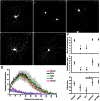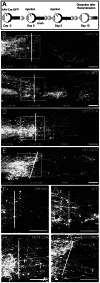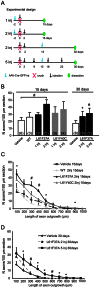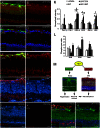Rac1 selective activation improves retina ganglion cell survival and regeneration
- PMID: 23734197
- PMCID: PMC3667179
- DOI: 10.1371/journal.pone.0064350
Rac1 selective activation improves retina ganglion cell survival and regeneration
Abstract
In adult mammals, after optic nerve injury, retinal ganglion cells (RGCs) do not regenerate their axons and most of them die by apoptosis within a few days. Recently, several strategies that activate neuronal intracellular pathways were proposed to prevent such degenerative processes. The rho-related small GTPase Rac1 is part of a complex, still not fully understood, intracellular signaling network, mediating in neurons many effects, including axon growth and cell survival. However, its role in neuronal survival and regeneration in vivo has not yet been properly investigated. To address this point we intravitreally injected selective cell-penetrating Rac1 mutants after optic nerve crush and studied the effect on RGC survival and axonal regeneration. We injected two well-characterized L61 constitutively active Tat-Rac1 fusion protein mutants, in which a second F37A or Y40C mutation confers selectivity in downstream signaling pathways. Results showed that, 15 days after crush, both mutants were able to improve survival and to prevent dendrite degeneration, while the one harboring the F37A mutation also improved axonal regeneration. The treatment with F37A mutant for one month did not improve the axonal elongation respect to 15 days. Furthermore, we found an increase of Pak1 T212 phosphorylation and ERK1/2 expression in RGCs after F37A treatment, whereas ERK1/2 was more activated in glial cells after Y40C administration. Our data suggest that the selective activation of distinct Rac1-dependent pathways could represent a therapeutic strategy to counteract neuronal degenerative processes in the retina.
Conflict of interest statement
Figures






References
-
- Schwab JM, Brechtel K, Mueller CA, Failli V, Kaps HP, et al. (2006) Experimental strategies to promote spinal cord regeneration–an integrative perspective. Prog Neurobiol 78: 91–116. - PubMed
-
- Liu K, Tedeschi A, Park KK, He Z (2011) Neuronal intrinsic mechanisms of axon regeneration. Annu Rev Neurosci 34: 131–152. - PubMed
-
- Di Giovanni S (2009) Molecular targets for axon regeneration: focus on the intrinsic pathways. Expert Opin Ther Targets 13: 1387–1398. - PubMed
-
- Gaub P, Joshi Y, Wuttke A, Naumann U, Schnichels S, et al. (2011) The histone acetyltransferase p300 promotes intrinsic axonal regeneration. Brain 134: 2134–2148. - PubMed
Publication types
MeSH terms
Substances
LinkOut - more resources
Full Text Sources
Other Literature Sources
Molecular Biology Databases
Research Materials
Miscellaneous

